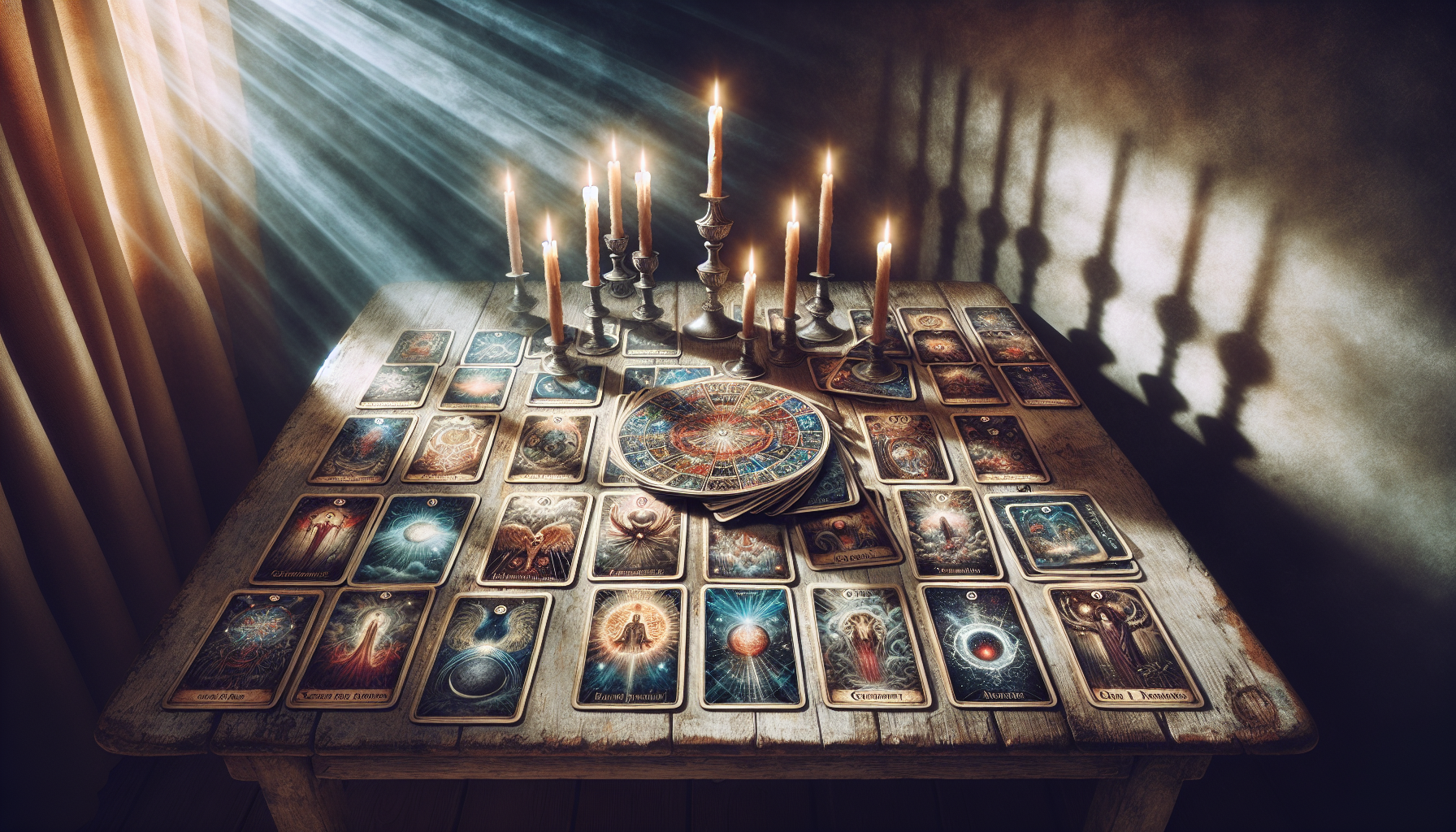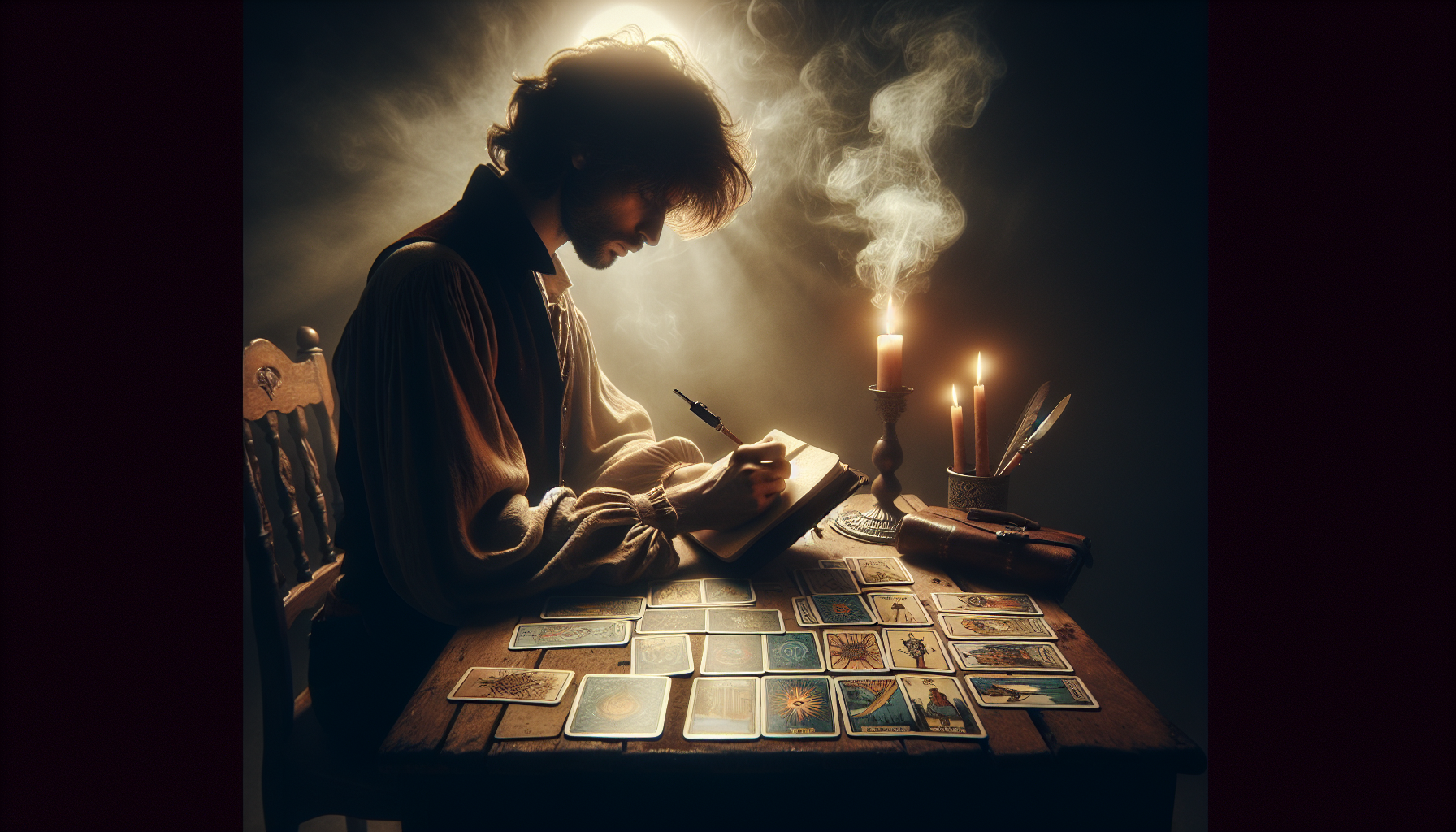Need quick answers from your tarot cards? Understanding ‘yes no in tarot’ can be straightforward and insightful. This guide demystifies yes-no readings, revealing how to phrase your questions, interpret card meanings, and confidently find the answers you seek. Dive into the realm of tarot with practicality as your compass, and learn how a simple card draw can illuminate your decision-making path with a clear tarot answer.
Key Takeaways
- Keep yes-or-no tarot questions simple and specific to get the clearest guidance – asking precise, focused questions helps the tarot give a straightforward answer.
- Single card tarot readings can provide quick insights for day-to-day decisions – just draw one card to address your query, avoiding complex spreads for these types of questions.
- Professional tarot readers can offer deeper understanding when answers aren’t clear – they help with more nuanced interpretations when self-readings leave you puzzled.
Unlocking the Power of Yes or No Tarot Readings

Yes or no tarot readings are the spiritual equivalent of a straightforward conversation with the cosmos. Designed for those simple day-to-day quandaries that require a crisp ‘yes’ or ‘no’ answer, these readings tap into the power of your tarot deck to offer instant clarity. Imagine pulling just a single tarot card and having an answer right at your fingertips—no complex spreads or convoluted interpretations needed. Whether seeking personal insights or a bit of fun, the key to a successful tarot reading lies in understanding how to formulate your question and interpret the card’s message.
While tarot cards are not crystal balls dictating a predetermined fate, they can certainly illuminate potential paths based on current circumstances, reminding us that we hold the reins of choice. The effectiveness of a tarot reading is intertwined with the belief in synchronicity—the coincidental yet meaningful alignment of events—and the querent’s mindset and expectations. But beyond predicting the future, tarot readings delve deep into the psyche, providing a mirror to our innermost thoughts, fears, and desires.
The Essence of a Yes or No Tarot Question
The core of a yes or no tarot reading resides in the question itself. A well-crafted inquiry is the cornerstone of receiving a definitive answer. It’s all about asking specific questions—short, succinct, and to the point. This precision cuts through the fog of ambiguity and allows the tarot to provide the most straightforward and understandable responses. By keeping your questions short and steering clear of multi-layered complexities, you ensure that the tarot can offer you an accurate snapshot answer to your yes or no question.
Maintaining objectivity is crucial to avoid being swayed by desired outcomes, which can lead to wishful thinking. The tarot is a tool for insight, not a way to confirm biases. When you approach your reading with a clear mind and an open heart, the cards will reflect the truth of your situation, guiding you towards the clarity you seek.
Identifying Your Yes, No, and Maybe Cards
Diving into the pool of tarot cards, including the major arcana, each one is imbued with its own personality and message, which are known as tarot card meanings. Some cards radiate positivity, like the triumphant 6 of Wands, signaling a resounding ‘yes,’ while others, such as the ominous 10 of Swords, lean towards a more definitive ‘no’. But tarot is not just black and white; shades of gray emerge in the form of ‘maybe’ or ‘uncertain’ responses, often represented by the court cards—pages, knights, queens, and kings. To delve deeper into these nuances, a more complex tarot spread can be utilized for greater insight.
Understanding these messages requires a deck-specific approach. Every tarot card holds a unique energy and meaning that contributes to a yes or no answer. Hence, getting to know your deck and the meanings of each card is key for a precise reading. And when you encounter a neutral card, it’s a gentle reminder that some answers are still in flux, or perhaps it’s an invitation to use the card’s meaning to help you carve out your own resolution.
Interpreting Reversed Tarot Cards in Yes or No Readings
Reversed tarot cards often add a twist to the plot of our tarot narratives. In the realm of yes or no questions, however, their role is a bit more nuanced. Common tarot practice reads all cards in the upright position, maintaining a clear dichotomy between yes and no. If you wish to intensify the depth of your readings, incorporating a reversed tarot card is an option. You can assign them a positive or negative orientation to influence the balance of answers.
But remember, there’s no one-size-fits-all approach here. Whether you include reversed tarot cards or not is a personal choice. Some tarot enthusiasts create their own methods, allowing these upside-down cards to influence the outcome and enrich the reading with depth and personal significance.
Crafting the Perfect Yes or No Tarot Inquiry

As you prepare to draw a card from your tarot deck, the clarity of your question holds utmost importance. The proverb ‘a well-asked question is half answered’ rings especially true in the field of tarot. Crafting a clear and focused question is akin to shining a spotlight on the path you wish to illuminate. It should be simple, seeking straightforward answers and avoiding the entanglements of complex scenarios or considerations.
The precision of your inquiry is not just about the wording—it’s about the intention behind it. Are you truly ready to hear the answer? Have you tuned out the noise of external expectations to hear the whisper of your own heart? A tarot reading is a dance with destiny, and your question is the music that sets the rhythm. By centering your question around personal choices and actions, you empower yourself to receive guidance that honors your free will.
Give your reading due gravity, infuse your question with the necessary focus and energy, and the cards will reciprocate.
Focusing Your Intentions
Intentions are the soul of your tarot inquiry, the silent prayers whispered into the universe’s ear. They guide the reading’s direction and depth, setting the stage for the insights to come. Be specific with your question, infuse it with a clear positive or negative intention, and, if appropriate, frame it within a time limit. This level of detail ensures you’re not just casting a line into the ocean of possibilities—you’re fishing in the right pond.
There are various ways to channel your intentions, from writing them down to vocalizing them or simply holding them firmly in your mind. Whatever your method, the act of setting an intention is a powerful ritual that brings more meaning and direction to the tarot reading experience. It’s like tuning an instrument before a performance, ensuring each note will resonate with clarity and purpose.
Avoiding Ambiguity
The art of tarot thrives on precision. When you ask a question, envision the tarot as a wise old friend who doesn’t mince words—someone who gives it to you straight, without room for misinterpretation. Ambiguity is the enemy of clarity, and in yes or no tarot readings, there’s no room for hesitation or half-measures.
By constructing your question to evoke a clear yes or no reply, the tarot’s response will penetrate the haze of uncertainty. The trick is in the phrasing. Craft your questions based on personal choices, not broad, sweeping queries that could be interpreted a dozen different ways.
Keep your questions simple and unambiguous, and the tarot will return the favor with tarot answers that shine a light on the path ahead, guiding you with the precision you need to move forward confidently.
Single Card Draw Methodology
In the world of tarot, less can be more, especially when it comes to yes-no questions. A single card draw is a razor-sharp method that gets straight to the heart of the matter. This technique is all about focus, allowing one card to encapsulate the essence of your inquiry. After each draw, return the card to the deck, reshuffle, and clear your mind. This ritual ensures that each answer is fresh, unbiased by previous draws, and aligned with the present moment.
It’s a straightforward process: formulate your question, shuffle your cards with intent, and draw a single card. The message it holds is your answer, free from the complexities of a more elaborate spread. This method is a testament to the power of simplicity—a single tarot card, a single question, a single moment of truth.
Enhancing Your Yes or No Tarot Experience

A tarot reading transcends the cards themselves—it encompasses the ambiance you create, the mindset you possess, and the receptiveness with which you accept the messages. To truly enhance your yes or no tarot reading, consider the space you’re in and your readiness to engage with the practice. A serene environment can sharpen your focus and deepen your connection with the cards, allowing you to tune into the subtleties of their guidance.
Before you shuffle your deck and lay out your cards, take a moment to breathe and center yourself. Are you ready to heed the tarot’s messages? Can you embrace the answers, regardless of whether they coincide with your hopes or defy your expectations? This readiness is an essential ingredient in the alchemy of a meaningful tarot reading.
Setting the Scene for Clarity
Imagine a clean, minimalist space that quiets the mind and directs your focus towards the cards in front of you. Comfortable seating, gentle lighting, perhaps the soft melody of ambient music—all of these elements coalesce to create a sanctuary for your tarot reading. In this haven, distractions fall away, and every card’s message resonates with heightened clarity.
Some tarot readers find the aromatic whisper of incense enhances the mood, but always consider personal sensitivities. What matters most is that your environment feels tranquil, a place where disturbances can’t reach you and your concentration remains unbroken, whether you’re consulting the cards in person or connecting with a reader over the phone. It’s about crafting a space where the tarot can speak, and you’re ready to listen.
Using Intuition as Your Guide
Intuition, the unspoken dialect of the soul, serves as your most reliable guide during tarot readings. You don’t need to be psychic or steeped in mysticism to engage with the tarot for self-reflection and personal growth. Tarot serves as a practical tool, bringing subconscious thoughts to the surface where you can examine them in the light of day.
To develop your intuition, consider your past decisions—those you made without the tarot’s guidance. Reflect on how those choices felt, and use that awareness to trust your intuitive judgment during readings. Remember, the tarot is a conduit for messages from the universe, but it’s your readiness to accept and interpret these messages that truly unlocks their power.
Seeking Professional Insight
There arrives a point in every tarot enthusiast’s journey when the cards’ messages become cryptic, and the answers aren’t as lucid as desired. In such moments, turning to a professional tarot reader can shed light on the shadows, offering deeper interpretations and more nuanced guidance. These seasoned guides can decipher the symbolism, take into account the card positions, and provide insights that go beyond a simple yes or no.
But beware of becoming too reliant on the tarot, making it a crutch for every decision you face. If you find yourself reaching for the deck out of habit or anxiety, it may be time to step back and reassess. Seek the advice of real psychics or professional readers only when necessary, and trust in your own intuition to lead the way.
Platforms like Keen offer a plethora of professional readings, allowing you to choose the reader and style that resonate with you.
Post-Reading Reflections: What Comes Next?

Although the cards have been drawn and the answers disclosed, the wisdom of tarot doesn’t cease when you reshuffle the deck. What follows is a period of contemplation, a chance to integrate the reading into your life and ponder its significance. Engage in reflective practices like journaling your thoughts, meditating on the implications, or sharing your experience with someone you trust. These are the steps that bring the tarot’s message from the ethereal realm into your tangible world.
If the tarot provides a ‘maybe,’ curb the impulse to instantly draw again for more clarity. Instead, give yourself time—days, weeks, even months—to let life unfold and the answers to crystallize naturally. Patience is a virtue in the journey of self-discovery, and the tarot respects the rhythms of life, advising us to let the messages and events develop in their own time before seeking further insight.
Contemplating the Tarot's Message
There’s something profoundly personal about holding a journal that chronicles your tarot journey. It becomes a repository of your questions, the cards you drew, and the insights you gleaned. By recording these sessions, you solidify the connection between the tarot’s symbolism and your life’s narrative. Journaling about the tarot isn’t just about keeping a record; it’s about engaging with the cards on a deeper level, allowing their wisdom to percolate through your consciousness and inform your decisions.
The tarot is a beacon when you’re at a crossroads or feeling lost, providing a fresh perspective that can illuminate hidden paths. It’s not about relinquishing control to the cards but rather using them as a tool to tap into your own intuition and judgement. Embrace the tarot’s guidance, ponder its messages, and let it be a companion on your journey towards clarity and self-awareness.
When to Revisit Your Question
In the realm of tarot, repetition can be a complex issue. Asking the same question over and over in the hopes of a different answer can cloud the cards’ message and diminish their accuracy. Trust in the tarot’s initial response, and resist the temptation to seek constant validation for your choices. If the answer was a ‘maybe,’ or if circumstances have significantly changed, it’s reasonable to revisit the question—but give it time. Allowing a span of several months before returning to the same inquiry can provide the space needed for situations to evolve and for you to reflect on the tarot’s advice.
This is not to imply that the tarot cannot serve as a regular companion in your life. Rather, it’s about approaching each reading with reverence and intention, ensuring that the guidance you receive is respected and not exploited. By spacing out your inquiries, you maintain the tarot’s sanctity and ensure that each reading is a meaningful step in your spiritual and personal growth.
Selecting Trustworthy Online Tarot Options
In an era where online divination is readily accessible, selecting a reliable online tarot service is of utmost importance. Amidst the surge of instant reading platforms, it’s important to filter out the valuable information from the irrelevant. Look for services that offer a range of readers and reading styles, ensuring that you find a match that resonates with your energy and expectations. The qualifications and experience of the tarot reader are also vital; these details can give you confidence in the guidance you’re about to receive.
While free tarot readings can be enticing, balance is key. A service that offers both free and paid options may indicate a commitment to accessibility as well as quality. Don’t forget to:
- Read user reviews or seek personal recommendations—these can be invaluable in finding a source that provides credible and insightful readings.
- Trust in your intuition as you navigate online tarot services.
- Remember, the right reader can make all the difference in your tarot experience.
Common Misconceptions About Yes or No Tarot Readings
Tarot readings have long been shrouded in mystery and myth, leading to misconceptions that can skew our expectations and understanding of their role in our lives. It’s crucial to recognize that tarot readings are meant to guide us, serving as a lens through which we can view our decisions and the potential paths before us. They are not meant to be the sole factor in making life choices. Depending excessively on tarot readings for each decision can result in a passive lifestyle, where personal autonomy is overshadowed by the cards.
Another widespread myth is that using tarot cards is akin to meddling with fate or that it brings bad luck. This view is more a product of sensationalist fiction than the reality of tarot’s practice. The tarot is a tool for reflection and exploration, not a device for altering destiny. By understanding the true nature of tarot readings, we can engage with them in a way that enriches our lives and empowers our decision-making.
Summary
As we reach the end of our tarot journey, let’s reflect on the key messages we’ve uncovered. Yes or no tarot readings are a powerful way to gain quick insights into life’s many questions. The clarity of these readings is rooted in the precision of our inquiries, the interpretations of the cards, and the intentions we set. By approaching tarot with an open mind, a clear question, and a reflective heart, we can harness its wisdom to illuminate the paths before us.
Embrace the tarot as a companion on your journey rather than a definitive answer to every crossroads. Use it as a tool for introspection, growth, and empowerment, and allow the insights you gain to guide you with confidence and clarity. Let the journey continue beyond the reading, as the true magic of tarot unfolds in the ways it inspires us to reflect, act, and evolve.
Frequently Asked Questions
Can tarot readings really predict the future?
No, tarot readings do not predict the future, but they offer guidance based on current circumstances to help you make informed choices and understand potential paths.
How often should I consult the tarot for guidance?
You should consult the tarot when you need guidance for a specific decision or clarity, but don't rely on it too heavily and give situations time to unfold naturally.
Do I need to be psychic to perform a tarot reading?
Nope, you don't need to be psychic to do a tarot reading. The tarot is a tool for self-reflection that anyone can learn to use and interpret.
Is it necessary to use reversed tarot cards in yes or no readings?
It's a personal choice whether to use reversed cards in yes or no readings. Some find it adds depth, while others prefer interpreting all cards upright for clarity.
How can I tell if an online tarot service is trustworthy?
To tell if an online tarot service is trustworthy, look for a diverse range of readers, check their credentials and experience, and read user reviews to gauge the quality and reliability of the readings offered. Always consider these factors before choosing a service.

